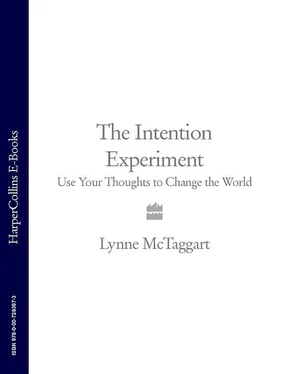Thirty years ago, while the rest of the scientific community carried on by rote, a small band of frontier scientists at prestigious universities around the globe paused to consider the metaphysical implications of the Copenhagen Interpretation and the observer effect. 6If matter was mutable, and consciousness made matter a set something, it seemed likely that consciousness might also be able to nudge things in a particular direction.
Their investigations boiled down to a simple question: if the act of attention affected physical matter, what was the effect of intention – of deliberately attempting to make a change? In our act of participation as an observer in the quantum world, we might be not only creators, but also influencers. 7
They began designing and carrying out experiments, testing what they gave the unwieldy label of ‘directed remote mental influence’ or ‘psychokinesis’, or, in shorthand, ‘intention’ or even ‘intentionality’. A textbook definition of intention characterizes it as ‘a purposeful plan to perform an action, which will lead to a desired outcome’, 8unlike a desire, which means simply focusing on an outcome, without a purposeful plan of how to achieve it. An intention was directed at the intender’s own actions; it required some sort of reasoning; it required a commitment to do the intended deed. Intention implied purposefulness: an understanding of a plan of action and a planned satisfactory result. Marilyn Schlitz, vice-president for research and education at the Institute of Noetic Sciences and one of the scientists engaged in the earliest investigations of remote influence, defined intention as ‘the projection of awareness, with purpose and efficacy, toward some object or outcome’. 9To influence physical matter, they believed, thought had to be highly motivated and targeted.
In a series of remarkable experiments, these scientists provided evidence that thinking certain directed thoughts could affect one’s own body, inanimate objects and virtually all manner of living things, from single-celled organisms to human beings. Two of the major figures in this tiny subgroup were former dean of engineering Robert Jahn at the Princeton Anomalies Engineering Research (PEAR) laboratory at Princeton University and his colleague Brenda Dunne, who together created a sophisticated, scholarly research programme grounded in hard science. Over 25 years, Jahn and Dunne led what became a massive international effort to quantify what is referred to as ‘micro-psychokinesis’, the effect of mind on random-event generators (REGs), which perform the electronic, twenty-first century equivalent of a toss of a coin.
The output of these machines (the computerized equivalent of heads or tails) was controlled by a randomly alternating frequency of positive and negative pulses. Because their activity was utterly random, they produced ‘heads’ and ‘tails’ each roughly 50 per cent of the time, according to the laws of probability. The most common configuration of the REG experiments was a computer screen randomly alternating two attractive images – say, of cowboys and Indians. Participants in the studies would be placed in front of the computers and asked to try to influence the machine to produce more of one image – more cowboys, say – then to focus on producing more images of Indians, and then to try not to influence the machine in either direction.
Over the course of more than two and a half million trials Jahn and Dunne decisively demonstrated that human intention can influence these electronic devices in the specified direction, 10and their results were replicated independently by 68 investigators. 11
While PEAR concentrated on the effect of mind on inanimate objects and processes, many other scientists experimented with the effect of intention on living things. A diverse number of researchers demonstrated that human intention can affect an enormous variety of living systems: bacteria, yeast, algae, lice, chicks, mice, gerbils, rats, cats and dogs. 12A number of these experiments have also been carried out with human targets; intention has been shown to affect many biological processes within the receiver, including gross motor movements and those in the heart, the eye, the brain and the respiratory system.
Animals themselves proved capable of acts of effective intention. In one ingenious study by René Peoc’h of the Fondation ODIER in Nantes, France, a robotic ‘mother hen’, constructed from a moveable random-event generator, was ‘imprinted’ on a group of baby chicks soon after birth. The robot was placed outside the chicks’ cage, where it moved around freely, as its path was tracked and recorded. Eventually, it was clear that the robot was moving towards the chicks two and a half times more often than it would ordinarily; the ‘inferred intention’ of the chicks – their desire to be close to their mother – appeared to affect the robot, drawing it closer to the cage. In over 80 similar studies, in which a lighted candle was placed on a movable REG, baby chicks kept in the dark, finding the light comforting, managed to influence the robot to spend more time than normal in the vicinity of their cage. 13
The largest and most persuasive body of research has been amassed by William Braud, a psychologist and the research director of the Mind Science Foundation in San Antonio, Texas, and, later, the Institute of Transpersonal Psychology. Braud and his colleagues demonstrated that human thoughts can affect the direction in which fish swim, the movement of other animals such as gerbils, and the breakdown of cells in the laboratory. 14
Braud also designed some of the earliest well-controlled studies of mental influence on human beings. In one group of studies, Braud demonstrated that one person could affect the autonomic nervous system (or fight-or-flight mechanisms) of another. 15Electrodermal activity (EDA) is a measure of skin resistance and shows an individual’s state of stress; a change of EDA usually occurs if someone is stressed or made uncomfortable in some way. 16Braud’s signature study tested the effect on EDA of being stared at, one of the simplest means of isolating the effect of remote influence on a human being. He repeatedly demonstrated that people were subconsciously aroused while they were being stared at. 17
Perhaps the most frequently studied area of remote influence concerns remote healing. Some 150 studies, of variable scientific rigour, have been carried out, 18and one of the best designed was conducted by the late Dr Elisabeth Targ. During the height of the AIDS epidemic in the 1980s, she devised an ingenious, highly controlled pair of studies, in which some 40 remote healers across America were shown to improve the health of terminal AIDS patients, even though the healers had never met or been in contact with their patients. 19
Even some of the most rudimentary mind-over-matter experiments have had tantalizing results. One of the first such studies involved attempts to influence a throw of the dice. To date, some 73 studies have examined the efforts of 2500 people to influence more than two and a half million throws of the dice, with extraordinary success. When all the studies were analysed together, and allowances made for quality or selective reporting, the odds of the results occurring by chance alone were 1076 (1 followed by 76 zeros) to one. 20
There was also some provocative material about spoon bending, that perennial party trick made popular by psychic Uri Geller. John Hasted, a professor at Birkbeck College at the University of London, had tested this with an ingenious experiment involving children. Hasted suspended latch keys from the ceiling and placed the children 3 to 10 feet away from their target key, so that they could have no physical contact. Attached to each key was a strain gauge, which would detect and register on a strip chart recorder any change in the key. Hasted then asked the children to try to bend the suspended metal. During the sessions, he observed not only the keys swaying and sometimes fracturing, but also abrupt and enormous spikes of voltage pulses up to 10 volts – the very limits of the chart recorder. Even more compelling, when children had been asked to send their intention to several keys hung separately, the individual strain recorders noted simultaneous signals, as though the keys were being affected in concert. 21
Читать дальше











